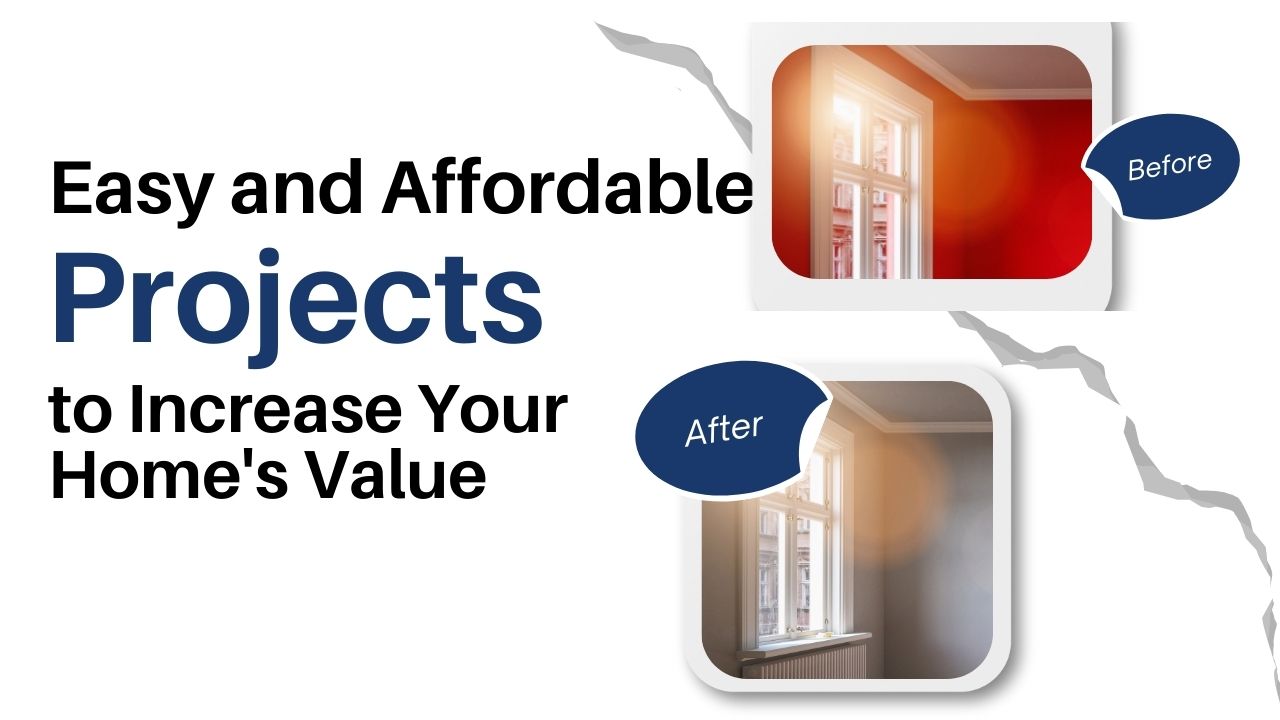 Whether you’re preparing to sell your home or simply want to enhance its appeal, increasing your home’s value doesn’t have to be expensive or time-consuming. With a few affordable projects, you can make your property stand out while staying within your budget.
Whether you’re preparing to sell your home or simply want to enhance its appeal, increasing your home’s value doesn’t have to be expensive or time-consuming. With a few affordable projects, you can make your property stand out while staying within your budget.
1. Boost Curb Appeal
First impressions are everything, and your home’s exterior is the first thing people see. Repaint the front door in an inviting color like navy blue or classic red, replace worn-out doormats, and upgrade your mailbox for a fresh look. Add some colorful potted plants or flower beds near the entryway for extra charm. Maintaining a tidy lawn by mowing, edging, and spreading fresh mulch can also make your home shine.
2. Modernize Lighting Fixtures
Outdated light fixtures can make your home feel older than it is. Replace them with sleek, modern designs or energy-efficient LED lighting. For added versatility, install dimmer switches to create the perfect mood in any room. Don’t forget to update outdoor lighting to enhance safety and nighttime curb appeal.
3. Refresh with Paint
One of the easiest and most cost-effective upgrades is painting. Neutral colors like soft grays, warm beiges, or off-whites make spaces feel larger and more inviting. Don’t just focus on walls—refinishing cabinets, repainting trim, or even giving your garage door a fresh coat can breathe new life into your home.
4. Upgrade Kitchens and Bathrooms
Kitchens and bathrooms sell homes, but full renovations can be pricey. Instead, focus on smaller upgrades like replacing old cabinet hardware with trendy brushed nickel or matte black options. Install a peel-and-stick backsplash for a stylish, modern touch. Replacing faucets, re-caulking sinks, and adding new towel racks can make your bathroom look like new.
5. Add Smart Home Features
Smart home technology appeals to today’s buyers. Start small with devices like a programmable thermostat, smart light bulbs, or a Wi-Fi-enabled video doorbell. These affordable additions make your home feel modern and convenient without requiring significant investment.
6. Declutter and Organize
A well-organized home appears larger and more functional. Clear out clutter, organize storage spaces, and depersonalize rooms to allow buyers to imagine themselves living there. Invest in decorative bins or shelving to keep everything neat and stylish.
7. Create Outdoor Living Spaces
Outdoor spaces are in demand, especially in today’s market. Adding a small patio seating area, stringing up fairy lights, or installing a fire pit can turn an ordinary backyard into a cozy retreat. These upgrades not only add value but also expand your usable living space.
By focusing on these simple and affordable projects, you can maximize your home’s value without spending a fortune. Whether you’re getting ready to sell or just want to enjoy your space more, these upgrades can make a big difference.
 Real estate has long been a proven path to building wealth, but many assume it’s only for the wealthy. The truth is, you don’t need a massive fortune to get started. With smart strategies and creativity, you can begin investing in real estate on a limited budget. Here’s how:
Real estate has long been a proven path to building wealth, but many assume it’s only for the wealthy. The truth is, you don’t need a massive fortune to get started. With smart strategies and creativity, you can begin investing in real estate on a limited budget. Here’s how: Owning a home is one of life’s most exciting and rewarding milestones. It represents stability, independence, and a place to truly call your own. But achieving the dream of homeownership doesn’t just happen overnight—it takes careful planning and preparation. The good news? By starting today, you can lay the foundation to make this year the one you finally cross the threshold into your new home.
Owning a home is one of life’s most exciting and rewarding milestones. It represents stability, independence, and a place to truly call your own. But achieving the dream of homeownership doesn’t just happen overnight—it takes careful planning and preparation. The good news? By starting today, you can lay the foundation to make this year the one you finally cross the threshold into your new home. The previous week’s reins were held by the Federal Reserve’s Rate Decision and also the preferred inflation indicator, the PCE Index. With the PCE Index coming in well above the Federal Reserve’s 2% target, it suggests that rate cuts may be postponed much longer this year than initially anticipated.
The previous week’s reins were held by the Federal Reserve’s Rate Decision and also the preferred inflation indicator, the PCE Index. With the PCE Index coming in well above the Federal Reserve’s 2% target, it suggests that rate cuts may be postponed much longer this year than initially anticipated. Would you feel comfortable living near a cemetery, or does the idea give you pause? For some, it’s no issue, while others might consider it a deal-breaker.
Would you feel comfortable living near a cemetery, or does the idea give you pause? For some, it’s no issue, while others might consider it a deal-breaker. Imagine relaxing by your own pool on a warm day, drink in hand, and a book by your side while the kids enjoy their favorite pool floats. Adding a pool to your property can feel like the ultimate luxury, but does it enhance your home’s value, or could it complicate resale?
Imagine relaxing by your own pool on a warm day, drink in hand, and a book by your side while the kids enjoy their favorite pool floats. Adding a pool to your property can feel like the ultimate luxury, but does it enhance your home’s value, or could it complicate resale?